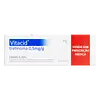What's inside
What's inside
 Key Ingredients
Key Ingredients

 Benefits
Benefits

 Concerns
Concerns

 Ingredients Side-by-side
Ingredients Side-by-side

Niacinamide
SmoothingTocopheryl Acetate
AntioxidantAscorbic Acid
AntioxidantPPG-7/Succinic Acid Copolymer
Ammonium Acryloyldimethyltaurate/Vinyl Formamide Copolymer
Emulsion StabilisingImidazolidinyl Urea
PreservativePropylene Glycol
HumectantDisodium EDTA
Cetearyl Alcohol
EmollientPolysorbate 60
EmulsifyingPetrolatum
EmollientPPG-14 Butyl Ether
Skin ConditioningBHT
AntioxidantDecyl Oleate
EmollientOleth-10 Phosphate
Dicetyl Phosphate
EmulsifyingMethylparaben
PreservativeEthylparaben
PreservativePropylparaben
PreservativeButylparaben
MaskingPhenoxyethanol
PreservativeDimethiconol
EmollientCyclopentasiloxane
EmollientCyclomethicone
EmollientParfum
MaskingWater
Skin ConditioningNiacinamide, Tocopheryl Acetate, Ascorbic Acid, PPG-7/Succinic Acid Copolymer, Ammonium Acryloyldimethyltaurate/Vinyl Formamide Copolymer, Imidazolidinyl Urea, Propylene Glycol, Disodium EDTA, Cetearyl Alcohol, Polysorbate 60, Petrolatum, PPG-14 Butyl Ether, BHT, Decyl Oleate, Oleth-10 Phosphate, Dicetyl Phosphate, Methylparaben, Ethylparaben, Propylparaben, Butylparaben, Phenoxyethanol, Dimethiconol, Cyclopentasiloxane, Cyclomethicone, Parfum, Water
 Reviews
Reviews

Alternatives
Ingredients Explained
These ingredients are found in both products.
Ingredients higher up in an ingredient list are typically present in a larger amount.
BHT is a synthetic antioxidant and preservative.
As an antioxidant, it helps your body fight off free-radicals. Free-radicals are molecules that may damage your skin cells.
As a preservative, it is used to stabilize products and prevent them from degrading. Specifically, BHT prevents degradation from oxidation.
The concerns related to BHT come from oral studies; this ingredient is currently allowed for use by both the FDA and EU.
However, it was recently restricted for use in the UK as of April 2024.
Learn more about BHTMethylparaben is a preservative and is a paraben. It is used to prevent the growth of fungus, mold, and other harmful bacteria. Parabens are chemicals used as preservatives in both cosmetics and food.
Methylparaben can be synthetically created. It can also be found naturally in some fruits, such as blueberries.
Oftentimes, Methylparaben is combined with other parabens to help increase the shelf life.
The safety of Methylparaben is currently being studied. While ongoing studies are looking into the safety of parabens, the results have been very mixed. Some studies have not found Methylparaben to be harmful.
Learn more about MethylparabenPropylparaben is a preservative and is a paraben with antifungal and antimicrobial properties.
This ingredient can be naturally found in plants and insects, but most of it is synthetically manufactured for human use. In cosmetics, it is usually created by reacting para-aminobenzoic acid and propanol (an alcohol).
You can usually find this ingredient in water-based products.
Parabens have come under controversy due to the claim they are hormone disruptors. Studies show conflicting results. We recommend speaking with a professional if you have any concerns.
Propylparaben is commonly found in food, medicine, and cosmetics.
Learn more about PropylparabenWater. It's the most common cosmetic ingredient of all. You'll usually see it at the top of ingredient lists, meaning that it makes up the largest part of the product.
So why is it so popular? Water most often acts as a solvent - this means that it helps dissolve other ingredients into the formulation.
You'll also recognize water as that liquid we all need to stay alive. If you see this, drink a glass of water. Stay hydrated!
Learn more about Water